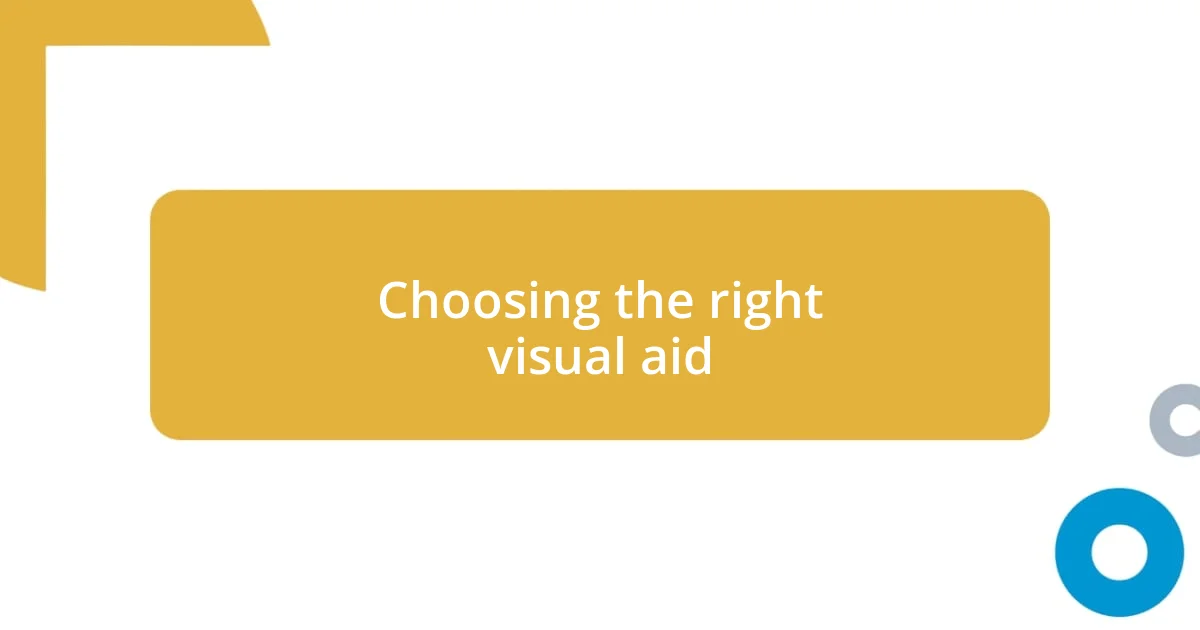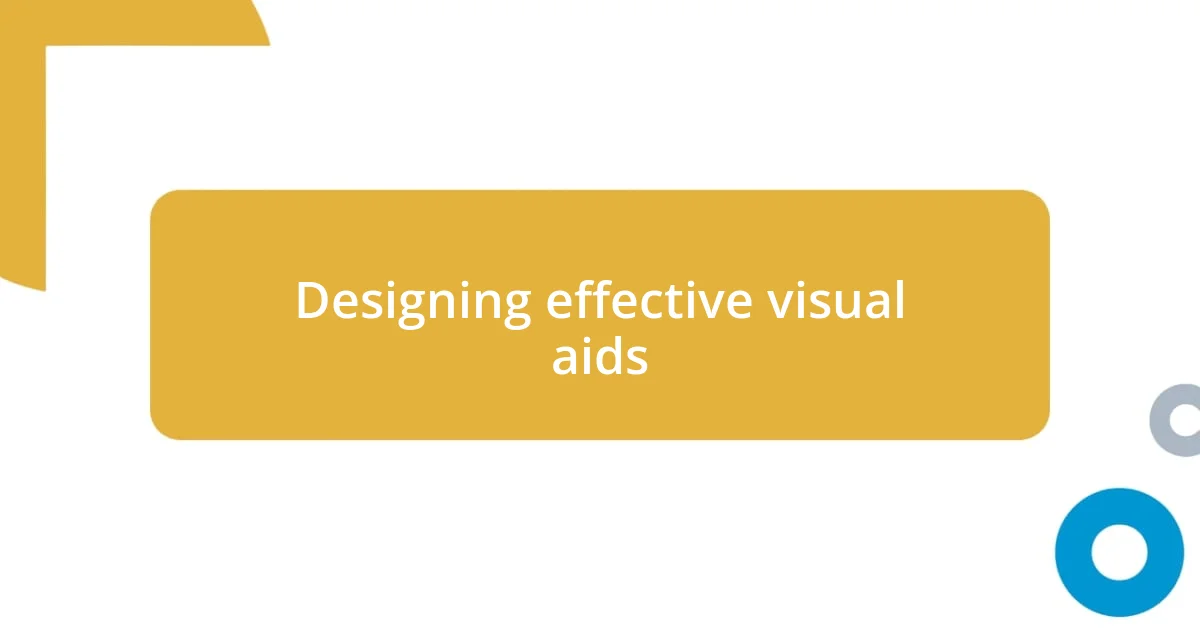Key takeaways:
- Visual aids significantly enhance audience engagement and comprehension by transforming complex information into easily digestible formats.
- Choosing the right visual aid and maintaining simplicity, clarity, and consistency in design are essential for effective communication.
- Integrating visuals with storytelling, interactive elements, and humor fosters a dynamic presentation atmosphere, encouraging audience participation.

Understanding visual aids
Understanding visual aids goes beyond just knowing what they are; it’s about appreciating their power to enhance communication. I remember the first time I used a chart in a presentation. The moment I saw my audience’s faces light up as they connected the dots made me realize how compelling a well-crafted visual can be.
Visual aids serve as bridges between complex information and audience comprehension. Have you ever found yourself lost in a sea of text during a presentation? I surely have. When I switched to incorporating visuals, I noticed not only an increase in engagement but also how quickly people grasped the concepts I was presenting. It’s astonishing how a simple image can evoke emotions and provoke thoughts.
When I think about effective visual aids, I often consider clarity and relevance. Using a cluttered slide can overwhelm rather than inform. I’ve learned through experience that a few well-chosen images or graphs can tell a story that lingers in the minds of my audience long after the presentation ends. Isn’t it rewarding to convey your message in such an unforgettable way?

Types of visual aids
Visual aids come in various types, each serving unique purposes and enhancing different aspects of communication. I often use PowerPoint slides for presentations because they allow for the integration of text, images, and graphs seamlessly. I remember during a workshop, using a mixture of bullet points and visuals helped my audience follow along and retain the information better than if I had relied solely on spoken words.
Charts and graphs also hold a special place in my presentations. They can transform abstract data into understandable visuals. For instance, when I presented statistics on customer satisfaction, a well-structured pie chart clearly showcased the proportions of responses, making it easier for everyone to grasp the key takeaways. It’s fascinating how these visuals make the information stick.
Another favorite of mine is the use of infographics. Their combination of design and concise information allows me to condense complex topics into digestible chunks. I recall creating an infographic for a marketing strategy overview, and the feedback was overwhelmingly positive. People appreciated how the visuals simplified dense data, allowing them to engage with the material without feeling overwhelmed.
| Type of Visual Aid | Benefits |
|---|---|
| PowerPoint Slides | Integrate various elements for engaging presentations. |
| Charts & Graphs | Visual representation of data for better understanding. |
| Infographics | Condense information into digestible visuals. |

Choosing the right visual aid
Choosing the right visual aid can make a significant difference in how effectively you communicate your message. I remember a project where I struggled to convey the importance of teamwork. Initially, I relied on bullet points. As the presentation unfolded, I noticed faces drifting away. Frustrated, I switched gears and used a relatable comic strip I found. Instantly, everyone was engaged, smiling, and connecting with the concept. That experience taught me that sometimes, a single visual can evoke a reaction that words alone cannot.
When selecting a visual aid, I always ask myself a few key questions to ensure alignment with my message:
- What is the primary takeaway I want my audience to remember?
- Does this visual aid enhance clarity or add unnecessary complexity?
- Is the visual engaging and appropriate for the audience’s cultural context?
These considerations have guided me to make choices that resonate with my listeners effectively, ensuring that the visuals not only support but also amplify my storytelling.

Designing effective visual aids
When designing effective visual aids, simplicity is crucial. I always strive to keep my visuals clear and uncluttered. A memorable experience from a recent training session reminded me how overwhelming too much information can be; my slide was packed with data, and I could see people squinting to catch every detail. I quickly learned that white space is my friend, as it guides the viewer’s focus.
Color also plays a pivotal role while designing visual aids. I vividly recall a project where I experimented with a vibrant color palette for my charts. The response was remarkable! My colleagues were more engaged and found it easier to follow along. I believe colors can evoke emotions and highlight essential points—just think about how red conveys urgency and blue exudes calmness.
Lastly, consistency in design goes a long way. I usually follow a theme throughout my presentation to create a cohesive experience. During one memorable company meeting, I maintained the same font and color scheme across all my slides. The visual flow made my message resonate better, and I sensed that my audience felt a part of a bigger narrative. Have you ever considered how a consistent layout can enhance your audience’s comprehension? It’s little details like these that elevate your visuals from ordinary to impactful.

Integrating visual aids into presentations
When it comes to integrating visual aids into presentations, timing and context matter immensely. I recall a particularly interactive workshop where I incorporated a live demo alongside my visual slides. The moment I showcased the product in real-time, the energy in the room shifted; eyes locked on me as curiosity sparked. Isn’t it fascinating how pairing visuals with action can deepen understanding, transforming a static presentation into a dynamic experience?
I’ve also learned that the placement of visual aids can enhance engagement significantly. For instance, during one presentation, I chose to keep my visuals to the side, allowing me to maintain eye contact with the audience. I noticed that this approach fostered a more conversational atmosphere, making people feel involved rather than passive observers. Have you ever felt more connected to a speaker when they engaged directly with you?
Moreover, I find that storytelling alongside visuals creates a captivating blend. In a recent meeting, I shared a personal story and punctuated it with relevant images that illustrated key moments. The blend of narrative and visual context transformed dry data into a relatable journey. The audience not only remembered my points but also connected emotionally. How impactful do you think it is when a story resonates visually? It’s moments like these that reinforce the power of harmonizing words and visuals.

Tips for engaging your audience
Engaging your audience truly begins with understanding their needs and interests. I once tuned into a webinar where the presenter promptly asked participants to share their expectations in the chat. It was surprising how quickly that simple step transformed the entire session; suddenly, we felt seen and acknowledged. Don’t underestimate the power of asking questions right off the bat—it creates an instant connection and sets the tone for interaction.
Another technique I enjoy using is incorporating visuals that invite participation. Picture this: during a team meeting, I displayed a simple poll graphic and encouraged everyone to vote on different options. The colors were vibrant and inviting, and the reaction was electric! As participants voiced their opinions and visually interacted with the aid, the atmosphere shifted from passive to lively. Isn’t it rewarding to see the enthusiasm spark when people feel like they have a say in the discussion?
Lastly, I find that leveraging humor through visuals can be highly effective. I remember one particular presentation where I included a light-hearted meme related to my topic. The room erupted in laughter, breaking the ice instantly. That moment not only lightened the mood but also made my message more relatable. How much more effective do you think your communication would be if you blended in humor? Creating a relaxed environment encourages openness and engagement, fostering a dialogue rather than a monologue.














